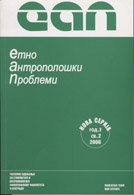Антрополошка проучавања феномена опседнутости: друштвени аспекти и импликације
Anthropological Research of the Phenomenon of Spirit Possession: Social Aspects and Implications
Author(s): Danijel SinaniSubject(s): Anthropology, Methodology and research technology, Sociology of Religion
Published by: Филозофски факултет, Универзитет у Београду
Keywords: possession; exorcism; theoretical approaches; social aspects of the phenomenon of possession;
Summary/Abstract: Spirit possession, in its many forms, represents an important factor in numerous religions and cults throughout the world. In the international context, work on spirit possession is abundant, and theories and their implications have been developed based on rich and lively ethnographic material gathered in many cultures. Unfortunately, in the context of national disciplinary production, this phenomenon was not thoroughly researched in anthropological circles. The most significant researcher of the problem of spirit possession and its social consequences is undisputedly British social anthropologist A.M. Lewis. Lewis introduced concepts such as peripheral and central possession to the study of spirit possession; he offered classification of different types of possession; and demonstrated that this phenomenon represents, for those who are in any way marginalized or disempowered, a rare opportunity to draw attention to their problems and a channel of vertical social mobility. Apart from the wide recognition and publicity it acquired, Lewis’ work also attracted a number of criticisms from authors of different background, but those criticisms are mostly poorly argumented or fail to take into account the additions and elaborations of results offered by Lewis himself. In the past decades, the problem of spirit possession has been approached from various points of view; ethnographies were filled with new examples; its various functions discovered in societies where it plays a significant role; and different theoretical and methodological approaches developed. Among the most significant contributions to the study of this phenomenon are those offered by authors such as Gellner, Gomm, Giles and Lambeck. However, after years of studying this phenomenon, we can conclude that even authors who claimed to be making a qualitative leap from A.M. Lewis’ approach just, in fact, applied his premises on new ethnographic material, and occasionally pointed to new functions or roles this phenomenon can assume in different communities.
Journal: Етноантрополошки проблеми
- Issue Year: 1/2006
- Issue No: 2
- Page Range: 59-78
- Page Count: 20
- Language: Serbian

